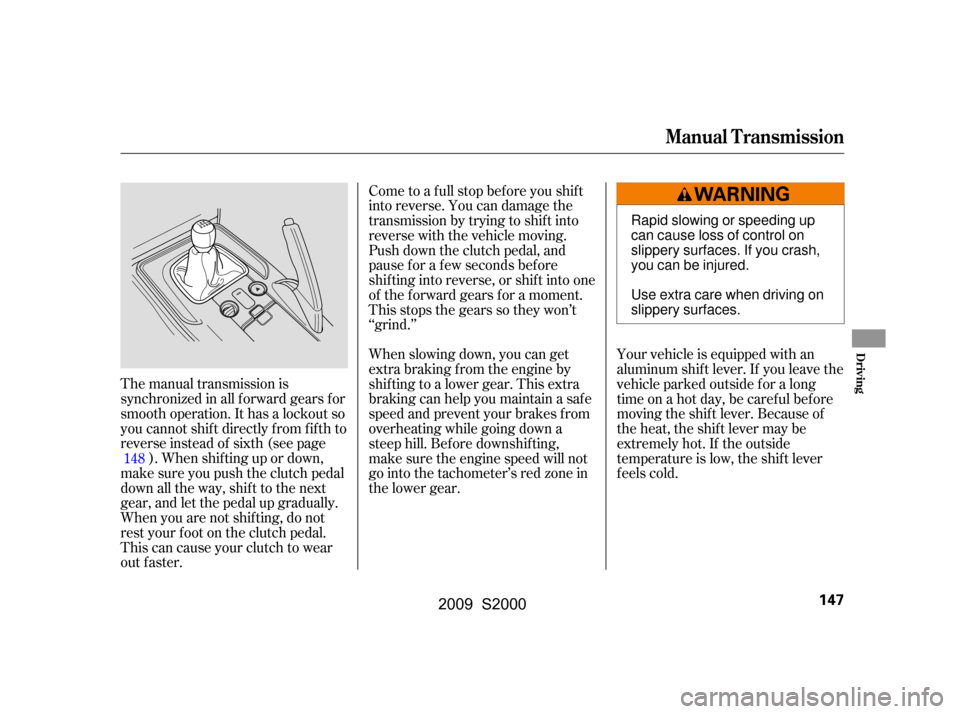2009 HONDA S2000 brakes
[x] Cancel search: brakesPage 49 of 268

The instrument panel has many
indicators to give you important
inf ormation about your vehicle.This indicator has two f unctions:
Itcomesonwhenyouturnthe
ignition switch to the ON (II)
position. It is a reminder to check
the parking brake. A beeper
sounds if you drive with the
parking brake not f ully released.
Driving with the parking brake not
f ully released can damage the
brakes and tires.
If you turn the ignition switch to the
ON (II) position bef ore f astening
your seat belts, the beeper sounds,
and the indicator f lashes. If you do
not fasten your seat belts before the
beeper stops, the indicator stops
f lashing but remains on. If this indicator comes on when the
engine is running, the battery is not
being charged. For more inf ormation,
see page . The engine can be severely damaged
if this indicator f lashes or stays on
when the engine is running. For
more information, see page . If either of you do not f asten your
seat belt while driving, the beeper
will sound and the indicator will f lash
again at regular intervals. For more
inf ormation, see page . If your passenger does not f asten
their seat belt, the indicator comes
on about 6 seconds af ter the ignition
switch is turned to the ON (II)
position.
If it stays on after you have fully
released the parking brake while
the engine is running, or if it
comes on while driving, there
could be a problem with the brake
system. For more inf ormation, see
page .
This indicator comes on when you
turn the ignition switch to the ON
(II) position. It reminds you and your
passenger to f asten your seat belts.
A beeper also sounds if you and your
passenger have not f astened your
seat belts.
2. 1.
16
218
218 220
Instrument Panel Indicators
Seat Belt Reminder
Indicator Parking Brake and
Brake System
Indicator
Charging System
Indicator L ow Oil Pressure
Indicator
46
U.S. Canada
2009 S2000
Page 91 of 268

To apply the parking brake, pull the
lever up f ully. To release it, pull up
slightly, push the button, and lower
the lever. The parking brake
indicator on the instrument panel
should go out when the parking
brake is f ully released (see page ).46
Parking Brake
88
BUTTON
PARKING BRAKE LEVER
Driving the vehicle with the parking
brake applied can damage the rear
brakes and hubs. A beeper will sound if
the vehicle is driven with the parking
brake on.
2009 S2000
Page 128 of 268

You can increase the set cruising
speed in any of these ways:Press and hold the RESUME/
accel button. When you reach the
desired cruising speed, release the
button.
Push on the accelerator pedal.
Accelerate to the desired cruising
speed, and press the SET/decel
button. You can decrease the set cruising
speed in any of these ways:
Press and hold the SET/decel
button. Release the button when
you reach the desired speed.
To slow down in very small
amounts, tap the SET/decel
button. Each time you do this,
your vehicle will slow down about
1 mph (1.6 km/h).
Tap the brake or clutch pedal
lightly with your f oot. The
CRUISE CONTROL indicator on
the instrument panel goes out.
When the vehicle slows to the
desired speed, press the SET/
decel button.
Cruise control may not hold the
set speed when you are going up
and down hills. If your speed
increases going down a hill, use
the brakes to slow down. This will
cancelthecruisecontrol.To
resume the set speed, press the
RESUME/accel button. The
indicator on the instrument panel
will come back on.
To increase the speed in very
small amounts, tap the RESUME/
accel button. Each time you do
this, your vehicle speeds up about
1 mph (1.6 km/h).
CONT INUED
Changing the Set Speed
Cruise Control
Features
125
2009 S2000
Page 131 of 268

Help assure your vehicle’s f uture
reliability and perf ormance by paying
extra attention to how you drive
during the f irst 600 miles (1,000 km).
During this period:Your vehicle is designed to operate
on premium unleaded gasoline with a
pump octane number of 91 or higher.
Useof aloweroctanegasolinecan
cause occasional metallic knocking
noises in the engine and will result in
decreased engine perf ormance. Use
of a gasoline with a pump octane
number less than 87 can lead to
engine damage.
You should also f ollow these
recommendations with an
overhauled or exchanged engine, or
when the brakes are replaced. Avoidhardbrakingforthefirst
200 miles (300 km).
Do not change the oil until the
scheduled maintenance time.
Avoid full-throttle starts and rapid
acceleration. Do not exceed 5,500
rpm f or the f irst 600 miles (1,000
km) of operation.
For f urther important f uel-related
inf ormation, please ref er to your.
If you notice any undesirable
operating symptoms, try another
service station or switch to another
brand of gasoline.
Some gasoline today is blended with
oxygenates such as ethanol or
MTBE. Your vehicle is designed to
operate on oxygenated gasoline
containing up to 10% ethanol by
volume and up to 15% MTBE by
volume. Do not use gasoline
containing methanol.
Use of gasoline with these additives
may adversely af f ect perf ormance,
and cause the malfunction indicator
lamp on your instrument panel to
come on. If this happens, contact
your authorized dealer f or service.
In addition, in order to maintain good
perf ormance, f uel economy, and
emissions control, we strongly
recommend, in areas where it is
available, the use of gasoline that
does NOT contain manganese-based
f uel additives such as MMT.
We recommend quality gasoline
containing detergent additives that
help prevent f uel system and engine
deposits.
Break-in Period
Fuel Recommendation
Quick Start Guide
Break-in Period, Fuel Recommendation
128
2009 S2000
Page 139 of 268

Your dealer has Honda accessories
that allow you to personalize your
vehicle. These accessories have
been designed and approved f or your
vehicle, and are covered by warranty.Bef ore installing any accessory:
Although non-Honda accessories
may f it on your vehicle, they may not
meet f actory specif ications, and
could adversely af f ect your vehicle’s
handling and stability.
Modif ying your vehicle, or installing
some non-Honda accessories, can
make it unsaf e. Bef ore you make any
modif ications or add any accessories,
be sure to read the f ollowing
inf ormation. When properly installed, cellular
phones, alarms, two-way radios, and
low-powered audio systems should
not interf ere with your vehicle’s
computer controlled systems, such
as your airbags, anti-lock brakes, and
tire pressure monitoring system. Bef ore installing any electronic
accessory, have the installer
contact your dealer. If possible,
have your dealer inspect the f inal
installation.
Be sure electronic accessories do
not overload electrical circuits
(see page ) or interf ere with
the proper operation of your
vehicle.
Make sure the accessory does not
obscure any lights, or interf ere
with proper vehicle operation or
perf ormance.
222
A ccessories
A ccessories and Modif ications
136
Improper accessories or
modifications can affect your
vehicle’s handling, stability, and
performance, and cause a
crash in which you can be hurt
or killed.
Follow all instructions in this
owner’s manual regarding
accessories and modifications.
2009 S2000
Page 140 of 268

Removing parts f rom your vehicle,
or replacing components with
non-Honda components could
seriously af f ect your vehicle’s
handling, stability, and reliability.
Herearesomeexamples:If you plan to modif y your vehicle,
consult your dealer.Modif ying your steering wheel or
any other part of your vehicle’s
saf ety systems could make the
systems inef f ective.
Larger or smaller wheels and tires
can interf ere with the operation of
your vehicle’s anti-lock brakes and
other systems.
Non-Honda wheels, because they
are a universal design, can cause
excessive stress on suspension
components and will not be
compatible with the tire pressure
monitoring system (TPMS).
Raising your vehicle with a
non-Honda suspension kit can
af f ect the handling and stability.
Lowering the vehicle with a non-
Honda suspension kit that
signif icantly reduces ground
clearance can allow the
undercarriage to hit speed bumps
or other raised objects, which
could cause the airbags to deploy.
Modif ying Your Vehicle
A ccessories and Modif ications
Bef ore Driving
137
2009 S2000
Page 146 of 268

........................
Driving Guidelines .144
........................
Preparing to Drive .145
.......................
Starting the Engine .146
...................
Manual Transmission .147
...........................................
Parking .149
.............................
Braking System .149
...............
Anti-lock Brakes (ABS) .150
Vehicle Stability Assist (VSA
),
aka Electronic Stability Control .......................
(ESC), System .152
Tire Pressure Monitoring System ......................................
(TPMS) .154
...........................
Towing a Trailer .157
This section gives you tips on
starting the engine under various
conditions, and how to operate the
manual transmission. It also includes
important inf ormation on parking
your vehicle, the braking system, the
vehicle stability assist (VSA
)
system, the tire pressure monitoring
system (TPMS), and f acts you need
if you are planning to tow a trailer.
Driving
Driving
143
2009 S2000
Page 150 of 268

The manual transmission is
synchronized in all f orward gears f or
smooth operation. It has a lockout so
you cannot shift directly from fifth to
reverse instead of sixth (see page). When shif ting up or down,
make sure you push the clutch pedal
down all the way, shift to the next
gear, and let the pedal up gradually.
When you are not shif ting, do not
rest your f oot on the clutch pedal.
This can cause your clutch to wear
out f aster. When slowing down, you can get
extra braking f rom the engine by
shifting to a lower gear. This extra
braking can help you maintain a safe
speed and prevent your brakes f rom
overheating while going down a
steep hill. Bef ore downshif ting,
make sure the engine speed will not
go into the tachometer’s red zone in
the lower gear.
Your vehicle is equipped with an
aluminum shif t lever. If you leave the
vehicle parked outside f or a long
time on a hot day, be caref ul bef ore
moving the shift lever. Because of
the heat, the shift lever may be
extremely hot. If the outside
temperature is low, the shif t lever
f eels cold.
Come to a full stop before you shift
into reverse. You can damage the
transmission by trying to shift into
reverse with the vehicle moving.
Push down the clutch pedal, and
pause f or a f ew seconds bef ore
shif ting into reverse, or shif t into one
of the f orward gears f or a moment.
This stops the gears so they won’t
‘‘grind.’’
148
Manual T ransmission
Driving
147
Rapid slowing or speeding up
can cause loss of control on
slippery surfaces. If you crash,
you can be injured.
Use extra care when driving on
slippery surfaces.
2009 S2000